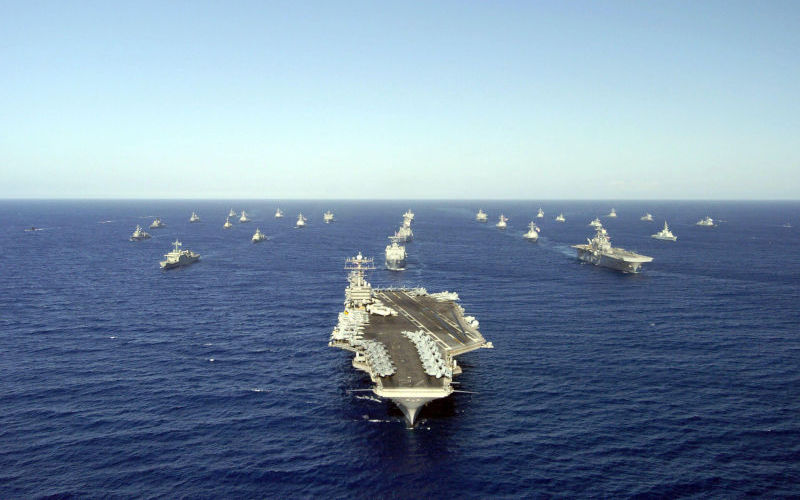People of Pacific Rim say 'no' to US-China war
June 20, 2025
The Pacific and Pacific Rim countries have a geographical commonality. They are encircled by, or have a border with, the vast, blue, peaceful Pacific Ocean.
They also share a political commonality. The people and countries of this region are under pressure to lift their military spending at the expense of addressing their social needs.
The pressure comes from the United States, whose Defence Secretary Peter Hegseth, at the recent Singapore Defence Summit, declared that the US expects its allies in this region to increase their defence spending to 5% of their GDP. His justification was a “possibly imminent threat” posed by China. He emphasised how the US is “reorienting towards deterring aggression by China” and made it clear that Donald Trump administration’s defence strategy revolves around stifling the rise of China.
Responding to this expectation would involve the doubling of South Korean expenditure on military defence, from 2.6% of its GDP to 5%.
It would mean Japan’s military defence spending would have to triple from 1.8 % of its GDP to 5%
For the Philippines, such an increase would mean a four-fold increase in defence military spending from 1.2% in 2023 to 5% of GDP.
In Australia, such an increase would represent a 2½ times increase from 2% to 5% of its GDP.
These examples show that the 5% target represents a massive increase in military spending which can only be made by reducing funding for urgent infrastructure, social needs such as health and education and loss of resources to address the real threat to their living environments, the climate crisis.
The question which the people of the Pacific and Pacific Rim countries are asking is, why do we have to respond to this demand by the US? We are not threatened by China. Where is the dire urgency which demands such a huge distortion of our public spending on the military?
Another commonality among the countries of the Pacific Rim, particularly those on the western and southern rim of the Pacific, is US troops and US military installations stationed on their territory. In the case of South Korea, these are substantial — close to 30,000 — and put that country’s military virtually under the control of the US.
Japan has 57,000 US troops including 20,000 on Okinawa where the US’s Kadena air base is its largest outside the US. Clearly, this level of foreign military occupation exerts substantial pressure on Japan’s foreign policy.
The Philippines has four US bases with US troops rotating through its territory and training with its defence forces and is setting up logistic centres for equipment and munitions.
The people of Guam, a territory under direct US control, is subject to 7000 US troops with almost a third of the land controlled by the US military. The Joint Region Marianas is a US military command combining the Anderson Air Force Base and the Naval Base Guam. Anderson Air Force Base hosts B-52 bombers and fighter jets. Naval Base Guam is the home port for four nuclear-powered fast attack submarines and two submarine tenders. American military commanders have referred to the island as their “permanent aircraft carrier”.
Australian Governments, in their subservience to the US, have signed the Force Posture Agreement giving the US military unimpeded access to Australia’s ports and airfields and is enabling the establishment of an NT base for its B-52 bombers, some of which are nuclear-capable. The agreement is giving the US fuel and munitions storage areas to support war operations and an $8 billion port facility for servicing their nuclear submarines and storage of their nuclear waste.
The people of Pacific Rim countries including Australia need to ask, “Why does the US have these extensive military facilities in our countries and why are they demanding such huge military expenditures of us?”
The answer unfortunately is not for the benefit of the people of this region but for its own foreign policy objectives, which include maintaining its dominance in the region by “containing” China and preventing the rise of its influence.
The indications are that the US is preparing for war against China but cannot wage such a war from the west coast of the US. It needs military bases, port facilities and airfields in the countries on the west side of the Pacific Rim, for example, South Korea, Japan, the Philippines, Guam, Micronesia and Australia. Without these bases, without the backing of the military forces and munitions and manufacturing capabilities of the Pacific Rim countries, the US cannot launch and sustain a war against China.
So the United States needs us but we don’t need such a war.
It would only bring devastation to our lives and our economies and if it turned nuclear who would survive?
The Pacific Peace Network, with representatives from the Pacific Rim countries and together with World Beyond War, has produced a solidarity campaign which is being launched on 21 June,2025.
This is a campaign in which the people of each country on the Pacific Rim, including Australia, can say “no” to such a war and “no” to an increase in military spending for it, through a common petition which is a call on their governments.
The common petition can be accessed at the World Beyond War website.
This call on governments reads:
For sustainable peace and the survival of our peoples and environment, we urge you to:
- Refuse to join military preparations for a US-China war;
- Declare you will not fight in a US-China war;
- Declare neutrality should such a war break out;
- Do not allow your territory or waters to be used in such a war, including the collection and relay of military intelligence, sales of weapons and hosting combatant troops and facilities
Later this year, the petitions will be presented to their respective governments by peace activists in each country.
The views expressed in this article may or may not reflect those of Pearls and Irritations.

